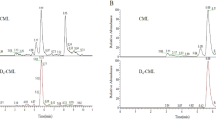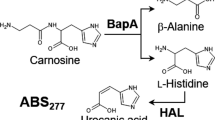Abstract
Formation of dietary advanced glycation end products has been extensively studied, principally with the aim to decrease their intake. In this work, the relationship between copper potentially present during food elaboration and N ε-(carboxymethyl)-l-lysine (CML) concentrations, has been examined for the first time. For CML determination, a reversed phase liquid chromatography-electrospray ionization-ion trap tandem mass spectrometry procedure, based on acid hydrolysis, ethyl chloroformate derivatization and quantification in MRM mode was set-up, yielding method quantification limit of 98 µg kg−1; copper was determined by ICP-MS. For eleven commercial cheeses, CML and Cu were found in the ranges 3.70–8.58 µg g−1 and 0.08–15.5 µg g−1, respectively, suggesting an inverse relation between these two parameters. For beef, chicken, Mexican pork “carnitas” and salmon, the CML concentration was lower in the item cooked in Cu casserole while element concentration was increased, as compared to this same raw material prepared in Teflon™ (except for “carnitas”). Concentration-dependent effect of Cu, manifest by decreased CML formation, was confirmed evaluating conversion percentage of chemically protected lysine (ZLys) to ZCML in the absence and in the presence of different Cu concentrations (50.0% and 20.4% conversion for Cu:ZLys molar ratio 0:1 and 0.04:1, respectively). Consistent results obtained in the analysis of three different sample types point to the inhibitory effect of copper during CML formation; however, it should be stressed that Cu is only one parameter within a complex set of factors/conditions involved in glycation process. Although better understanding of the observed effect at molecular level is needed, the results obtained in this work strongly suggest beneficial effect of copper, inhibiting glycation process during food elaboration.





Similar content being viewed by others
References
Poulsen MW, Hedegaard RV, Andersen JM, de Courten B, Bügel S, Nielsen J, Skibsted LH, Dragsted LO (2013) Advanced glycation end products in food and their effects on health. Food Chem Toxicol 60:10–37
Lapolla A, Traldi P, Fedel D (2005) Importance of measuring products of non-enzymatic glycation of proteins. Clin Biochem 38:103–115
Ames JM (2008) Determination of N ε-(carboxymethyl)lysine in foods and related systems. Ann N Y Acad Sci 1126:20–24
Tessier JF (2010) The Maillard reaction in the human body. The main discoveries and factors that affect glycation. Pathol Biol 58:214–219
Nguyen HT, van der Fels-Klerx HJ, van Boekel MAJS (2014) N-(carboxymethyl)lysine: a review on analytical methods, formation, and occurence in processed food, and health impact. Food Rev Int 30:36–52
Thorpe SR, Bayens JW (2002) CML: a brief history. Int Congr Ser 1245:91–99
Tessier FJ, Birlouez-Aragon I (2012) Health effects of dietary Maillard reaction products: the results of ICARE and other studies. Amino Acids 42:1119–1131
Vistoli G, De Maddis D, Cipak A, Zarkovic N, Carini M, Aldini G (2013) Advanced glycoxidation and lipoxidation end products (AGEs and ALEs): an overview of their mechanisms of formation. Free Radic Res 47(Suppl. 1):3–27
Bodiga VL, Eda SR, Bodiga S (2014) Advanced glycation end products: role in pathology of diabetic cardiomyopathy. Heart Fail Rev 19:49–63
Kumar Pasupulati A, Chitra PS, Reddy GB (2016) Advanced glycation end products mediated cellular and molecular events in the pathology of diabetic nephropathy. Biomol Concepts 7:293–309
Van Puyvelde K, Mets T, Njemini R, Beyer I, Bautmans I (2014) Effect of advanced glycation end product intake on inflammation and aging: a systematic review. Nutr Rev 72:638–650
Delgado-Andrade C (2016) Carboxymethyl-lysine: thirty years of investigation in the field of AGE formation. Food Funct 7:46–57
Hull GLJ, Woodside JV, Ames JM, Cusk GJ (2013) Validation study to compare effects of processing protocols on measured N ε-(carboxymethyl)lysine and N ε-(carboxyethyl)lysine in blood. J Clin Biochem Nutr 53:129–133
Hull GLJ, Woodside JV, Ames JM, Cuskelly GJ (2012) N ε-(carboxymethyl)lysine content of foods commonly consumed in a Western style diet. Food Chem 131:170–174
Assar S, Moloney C, Lima M, Magee R, Ames JM (2009) Determination of N ε-(carboxymethyl)lysine in food systems by ultra performance liquid chromatography–mass spectrometry. Amino Acids 36:317–326
Chen G, Smith JS (2015) Determination of advanced glycation endproducts in cooked meat products. Food Chem 168:190–195
Scheijen JLJM, Clevers E, Engelen L, Dagnelie PC, Brouns F, Stehouwer CDA, Schalkwijk CG (2016) Analysis of advanced glycation endproducts in selected food items by ultra-performance liquid chromatography tandem mass spectrometry: presentation of a dietary AGE database. Food Chem 190:1145–1150
Sun X, Tang J, Wang J, Rasco BA, Lai K, Huang Y (2016) Formation of N ε-carboxymethyllysine and N ε-carboxyethyllysine in ground beef during heating as affected by fat, nitrite and erythorborate. J Food Meas Charact. doi:10.1007/s11694-016-9400-6
Zhou Y, Lin Q, Jin C, Cheng L, Zheng X, Dai M, Zhang Y (2015) Simultaneous analysis of N ε-(carboxymethyl)lysine and N ε-(carboxyethyl)lysine in foods by ultra-performance liquid chromatography-mass spectrometry with derivatization by 9-fluorenylmethyl chloroformate. J Food Sci 80:C207–C217
Srey C, Hull GL, Connolly L, Elliott CT, del Castillo MD, Ames JM (2010) Effect of inhibitor compounds on Nε-(carboxymethyl) lysine (CML) and N ε-(carboxyethyl) lysine (CEL) formation in model foods. J Food Agric Chem 58:12036–12041
Roldan M, Loebner J, Degen J, Henle T, Antequera T, Ruiz-Carrascal J (2015) Advanced glycation end products, physico-chemical and sensory characteristics of cooked lamb loins affected by cooking method and addition of flavour precursors. Food Chem 168:487–495
Akıllıoglu HG, Gökmen V (2016) Kinetic evaluation of the inhibition of protein glycation during heating. Food Chem 196:1117–1124
Wilker D, Heinrich AB, Kroh LW (2015) Model studies on the antioxidative effect of polyphenols in thermally treated d-glucose/l-alanine solutions with added metal ions. J Agric Food Chem 63:10973–10979
Nashalian O, Yaylayan VA (2015) Sugar-conjugated bis(glycinato)copper(II) complexes and their modulating influence on the Maillard reaction. J Agric Food Chem 63:4353–4360
Ramonaityte DT, Keršiene M, Adams A, Tehrani KA, De Kimpe N (2009) The interaction of metal ions with Maillard reaction products in a lactose–glycine model system. Food Res Int 42:331–336
Baraka-Vidot J, Navarra G, Leone M, Bourdon E, Militello V, Rondeau P (2014) Deciphering metal-induced oxidative damages on glycated albumin structure and function. Biochim Biophys Acta 1840:1712–1724
Arasteh A, Farahi S, Habibi-Rezaei M, Moosavi-Movahedi AA (2014) Glycated albumin: an overview of the in vitro models of an in vivo potential disease marker. J Diabetes Metab Disord 13:49. doi:10.1186/2251-6581-13-49
Ramirez Segovia AS, Wrobel K, Acevedo Aguilar FJ, Corrales Escobosa AR, Wrobel K (2017) Effect of Cu(II) on in vitro glycation of human serum albumin by methylglyoxal: a LC–MS-based proteomic approach. Metallomics 9:132–140
Rodríguez LM, Alatossava T (2008) Effects of copper supplement on growth and viability of strains used as starters and adjunct cultures for Emmental cheese manufacture. J Appl Microbiol 105:1098–1106
Rodriguez ML, Ritvanen T, Joutsjoki V, Rekonen J, Alatossava T (2011) The role of copper in the manufacture of Finnish Emmental cheese. J Dairy Sci 94:4831–4842
Gomez Ojeda A, Wrobel K, Corrales Escobosa AR, Torres Elguera JC, Garay-Sevilla ME, Wrobel K (2015) Molybdenum and copper in four varieties of common bean (Phaseolus vulgaris): new data of potential utility in designing healthy diet for diabetic patients. Biol Trace Elem Res 163:244–254
ICH (2012) ICH harmonized tripartite guideline. Validation of analytical procedures: text and methodology (Q2/R1). http://www.ish.org/fileadmin/Public_Web_Site/ICH_Products/Guidelines/Quality/Q2_R1/Step4/Q2_R1_Guideline.pdf. Accessed 20 Apr 2017
Jaramillo Ortiz S, Wrobel K, Corrales Escobosa AR, Wrobel K (2015) Effect of different chemical agents on the formation of N ε-carboxymethyl-lysine using glyoxylic acid a universal metabolite associated with the development and progression of diabetes. Acta Univ 25:17–21
Husek P (1998) Chloroformates in gas chromatography as general purpose derivatizing agents. J Chromatogr B 717:57–91
Petrovic R, Futas J, Chandoga J, Jakus V (2005) Rapid and simple method for determination of N ε-(carboxymethyl)lysine and N ε-(carboxyethyl)lysine in urine using gas chromatography/mass spectrometry. Biomed Chromatogr 19:649–654
Bakircioglu D, Kurtulus YB, Ucar G (2011) Determination of some traces metal levels in cheese samples packaged in plastic and tin containers by ICP-OES after dry, wet and microwave digestion. Food Chem Toxicol 49:202–207
Montanari A (2015) Inorganic contaminants of food as a function of packaging features. In: Barona C, Bolzani L, Caruso G, Monatanri A, Parisi S, Steinka I (eds) Food packaging hygiene. Springer International Publishing, pp 17–41
Lemos Batista B, Grotto D, Hornos Carneiro MF, Barbosa FJ (2012) Evaluation of the concentration of nonessential and essential elements in chicken, pork, and beef samples produced in Brazil. J Toxicol Environ Health Part A 75:1269–1279
Gerber N, Brogioli R, Hattendorf B, Scheeder MRL, Wenk C, Gunther D (2009) Variability of selected trace elements of different meat cuts determined by ICP-MS and DRC-ICPMS. Animal 3:166–172
Saiki MK, Martin BA, Thompson LD, Welsh D (2001) Copper, cadmium, and zinc concentrations in juvenile chinook salmon and selected fish-forage organisms (aquatic insects) in the upper Sacramento River, California. Water Air Soil Pollut 132:127–139
Uribarri J, Woodruff S, Goodman S, Cai W, Chen X, Pyzik R, Yong A, Striker GE, Vlassara H (2010) Advanced glycation end products in foods and a practical guide to their reduction in the diet. J Am Diet Assoc 110:911–916
Tanaka A, Kaneto H, Miyatsuka T, Yamamoto K, Yoshiuchi K, Yamasaki Y, Shimomura I, Matsuoka TA, Matsuhisa M (2009) Role of copper ion in the pathogenesis of type 2 diabetes. Endocr J 56:699–706
Meyer JA, Spencer DM (2009) A perspective on the role of metals in diabetes: past findings and possible future directions. Metallomics 1:32–49
Jomova K, Valko M (2011) Advances in metal-induced oxidative stress and human disease. Toxicology 283:65–87
Tarwadi KV, Agte VV (2011) Effect of micronutrients on methylglyoxal-mediated in vitro glycation of albumin. Biol Trace Elem Res 143:717–725
Saari JT, Dahlen GM (1999) Early and advanced glycation end-products are increased in dietary copper deficiency. J Nutr Biochem 10:210–214
Conato C, Contino A, Maccarrone G, Magri A, Remelli M, Tabbi G (2000) Copper(II) complexes with l-lysine and l-ornithine: is the side-chain involved in the coordination? A thermodynamic and spectroscopic study. Thermochim Acta 362:13–23
Argirova MD, Ortwerth BJ (2003) Activation of protein-bound copper ions during early glycation: study on two proteins. Arch Biochem Biophys 420:176–184
Nashalian O, Yaylayan VA (2014) Thermally induced oxidative decarboxylation of copper complexes of amino acids and formation of Strecker aldehyde. J Agric Food Chem 62:8518–8523
Corrales Escobosa AR, Wrobel K, Yanez Barrientos E, Jaramillo Ortiz S, Ramirez Segovia AS, Wrobel K (2015) Effect of different glycation agents on Cu(II) binding to human serum albumin studied by liquid chromatography, nitrogen microwave plasma atomic emission spectrometry, inductively coupled plasma mass spectrometry and high resolution molecular mass spectrometry. Anal Bioanal Chem 407:1149–1157
Seneviratne C, Dombi GW, Liu W, Dain JA (2011) The in vitro glycation of human serum albumin in the presence of Zn (II). J Inorg Biochem 105:1548–1554
Macru A, Stanila A, Rusu D, Rusu M, Cozar O, David L (2007) Spectroscopic studies of copper (II) complexes with some amino acids. J Optron Adv Mater 9:741–746
Acknowledgements
The financial support from National Council of Science and Technology, Mexico (CONACYT), Project 123732, is gratefully acknowledged. The authors thankfully acknowledge the support from the University of Guanajuato, Projects 800/2016 and 721/2016.
Author information
Authors and Affiliations
Corresponding author
Ethics declarations
Conflict of interest
All authors declare no conflict of interest.
Human or animal rights
All authors declare that this study does not include any experiments with human or animal subjects.
Electronic supplementary material
Below is the link to the electronic supplementary material.
Rights and permissions
About this article
Cite this article
Jaramillo Ortiz, S., Wrobel, K., Gomez Ojeda, A. et al. N ε-(carboxymethyl)-l-lysine content in cheese, meat and fish products is affected by the presence of copper during elaboration process. Eur Food Res Technol 244, 225–234 (2018). https://doi.org/10.1007/s00217-017-2949-4
Received:
Revised:
Accepted:
Published:
Issue Date:
DOI: https://doi.org/10.1007/s00217-017-2949-4




